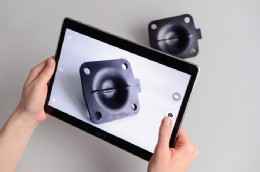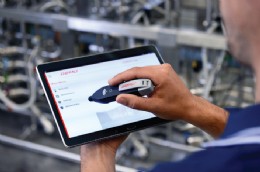RFID Chips on Valves and Actuators?



GEMÜ recognised this growing need and developed an RFID chip and software system that can operate as the maintenance, document store and resource database for plant components. The idea is simple, yet the development of the RFID chips, mounting technique and software development has taken years to complete. It is called CONEXO.
The CONEXO system comprises an integrated RFID chip (eg fixed to a valve, pump or instrument body, housing, seals or actuator), an electronic reading device - the CONEXO pen and an IT infrastructure comprising a CONEXO app for mobile devices and the CONEXO portal server as a central database ideally installed at the operator's premises.
How the CONEXO system works
CONEXO allows the maintenance technician to attend a valve or pump for example; read the RFID chip with the CONEXO pen and call up the current information of the process component; for instance the valve description, instructions, test reports, material certificates, product datasheets or maintenance information.
No online connection is required for this; the data is saved on a mobile device. Since the information can be read out at the valve itself, the IQ process (Installation Qualification) is speeded up as the required documents and test reports can be called up and compared quickly and easily.
Yet this is the beginning of the features of the CONEXO system. The CONEXO system also offers major advantages for maintenance processes as the maintenance documentation is stored electronically in the CONEXO app.
A maintenance technician is assigned the maintenance task electronically on their tablet and can clearly identify the relevant valves and perform the maintenance work. This also allows the maintenance technician to be clearly verified as a trained person able to perform the maintenance work and document it.
On site, after scanning the RFID chip, they are guided through the maintenance processes, can record the evaluation of wearing parts electronically and can actually verify this via photographic documentation. Technicians can literally photograph seals as they are removed, zoom in on seat wear or corrosion or generally confirm suitability for the component to continue service by photographic evidence or to complete repairs. This photographic data is logged in the database against that unique RFID tag and can be viewed at any time.
The CONEXO system allows specific data to be recorded and also further processed electronically in a simple manner, whether for the customer's SCADA environment or in the customer's ERP system. The CONEXO portal can be used to analyse the history of process plant, even in different locations. This enables maintenance intervals to also be optimally adapted to actual site conditions. If the component data shows the item is still good after inspection, then maintenance periods could be reduced and extended thus saving money.
CONEXO is designed as an open system which means that any other plant components can be managed in the system.
Imagine a Globe or a Control valve placed in service. The CONEXO pen scans the RFID tag, logs the Valve details, Supplier, Order codes, Order number; holds its Technical Datasheets, Operating and Maintenance instructions, Melt certificates, Flow test certificates, ATEX certification and also holds a service guide or even video that leads a technician through a repair sequence – step by step – then waits for photographs of the valve to be taken and uploaded so that at the original installation and every subsequent change of diaphragms, seals, repairs, new actuator or switchboxes the valve condition can be recorded and held in the CONEXO database. Process information such as the 'time of last maintenance‘ can also be displayed.
What is the worth to a plant operator?
If a plant operator installed such a system, how many different types of process components would they like to be registered in it? Pumps, valves, actuators and instruments are just a beginning.
Gemu have site tested the system with Diaphragm valves as an example. The valve tag, body, diaphragm, actuator and switchbox have a RFID tag each. The valve tag is registered with the body, diaphragm, actuator and switchbox tags as components.
The technician on site wants to assess the condition of the actuator
• Scan the valve RFID tag into CONEXO
• The valve data is displayed
• Dismantle the valve and assess condition of the actuator.
• Select the actuator sub-component in CONEXO
• If the actuator is good they can add photographic evidence to the database & exit
• If it needs replacing they scan the existing actuator RFID tag
• Add photographs of condition and comments
• Then they scan the new actuator RFID which then replaces the first one in the database
• The valve tag now show a new sub-component actuator via its new RFID tag
• The old actuator data is held indefinitely
• He exits the program.
This capability pushes maintenance and plant control into new areas not available yet in the Process Industry. Conexo can do this.
What is the value to a Valve and Actuator manufacturer?
The interaction between valve components equipped with RFID chips and an IT infrastructure, comprising the CONEXO APP and the CONEXO Portal, will actively improve process reliability.
Every valve, pump or instrument and every relevant component, such as the body, actuator or seals, can be clearly traced using RFID chips and read off at any time in the system. This provides vastly increased benefits to manufacturers customers. If most plant components had CONEXO RFID chips how much simpler for the plant operator to control their maintenance routines? Scheduled downtimes should also be kept as short as possible – any simplification in the maintenance process shortens the duration of the maintenance work and thus the system downtime.
GEMÜ CONEXO is the first step towards simplified and faster maintenance processes but plant operators need their component suppliers “on board” with CONEXO so that the system works even better. If the manufacturer could equip valves and/or the relevant valve components, such as bodies, actuators and seals, with RFID chips – what a step forward for the manufacturer.
This not only enables components and wearing parts to be clearly traced electronically, but also improves identification in the field.
Gemu have developed the CONEXO system for their own products and certainly since launch there has been a huge welcome reception to this system. RFID chips are being mounted to valve bodies, actuators and also embedded inside rubber seals. Already one skid builder has adopted the system for every skid produced so that clients can actively maintain skid components via CONEXO. Pharmaceutical companies are also looking at the system for valve identification, maintenance and seal changes. It has only been launched a few months ago!
CONEXO – a phenomenal new idea!
Tel: +44(0)1925 824044
Email: sales@gemu.co.uk
Web: www.gemu-group.com

| Telephone: | 01925 824044 |
| Email: | sales@gemu.co.uk |
| Website: | www.gemu.co.uk |
| More information on the Gemu Valves Ltd BVAA Member Directory Page |
Search related valve / actuator articles: Gemu Valves LtdIssue 41System ControlWirelessTransmittersFieldbusProximity SwitchesControl PanelsPositioners







-web.jpg)





